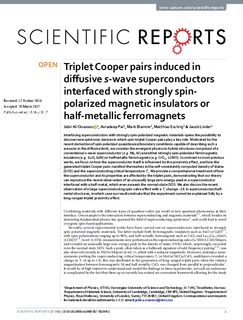| dc.contributor.author | Ouassou, Jabir Ali | |
| dc.contributor.author | Pal, Avradeep | |
| dc.contributor.author | Blamire, Mark | |
| dc.contributor.author | Eschrig, Matthias | |
| dc.contributor.author | Linder, Jacob | |
| dc.date.accessioned | 2017-05-18T07:36:51Z | |
| dc.date.available | 2017-05-18T07:36:51Z | |
| dc.date.created | 2017-05-16T16:29:42Z | |
| dc.date.issued | 2017 | |
| dc.identifier.citation | Scientific Reports. 2017, 7 . | nb_NO |
| dc.identifier.issn | 2045-2322 | |
| dc.identifier.uri | http://hdl.handle.net/11250/2442704 | |
| dc.description.abstract | Interfacing superconductors with strongly spin-polarized magnetic materials opens the possibility to discover new spintronic devices in which spin-triplet Cooper pairs play a key role. Motivated by the recent derivation of spin-polarized quasiclassical boundary conditions capable of describing such a scenario in the diffusive limit, we consider the emergent physics in hybrid structures comprised of a conventional s-wave superconductor (e.g. Nb, Al) and either strongly spin-polarized ferromagnetic insulators (e.g. EuO, GdN) or halfmetallic ferromagnets (e.g. CrO2, LCMO). In contrast to most previous works, we focus on how the superconductor itself is influenced by the proximity effect, and how the generated triplet Cooper pairs manifest themselves in the self-consistently computed density of states (DOS) and the superconducting critical temperature T c . We provide a comprehensive treatment of how the superconductor and its properties are affected by the triplet pairs, demonstrating that our theory can reproduce the recent observation of an unusually large zero-energy peak in a superconductor interfaced with a half-metal, which even exceeds the normal-state DOS. We also discuss the recent observation of a large superconducting spin-valve effect with a T c change ~1 K in superconductor/half-metal structures, in which case our results indicate that the experiment cannot be explained fully by a long-ranged triplet proximity effect. | nb_NO |
| dc.language.iso | eng | nb_NO |
| dc.publisher | Nature Publishing Group | nb_NO |
| dc.rights | Navngivelse 4.0 Internasjonal | * |
| dc.rights.uri | http://creativecommons.org/licenses/by/4.0/deed.no | * |
| dc.title | Triplet Cooper pairs induced in diffusive s-wave superconductors interfaced with strongly spin-polarized magnetic insulators or half-metallic ferromagnets | nb_NO |
| dc.type | Journal article | nb_NO |
| dc.type | Peer reviewed | nb_NO |
| dc.source.pagenumber | 16 | nb_NO |
| dc.source.volume | 7 | nb_NO |
| dc.source.journal | Scientific Reports | nb_NO |
| dc.identifier.doi | 10.1038/s41598-017-01330-1 | |
| dc.identifier.cristin | 1470622 | |
| dc.description.localcode | Open Access This article is licensed under a Creative Commons Attribution 4.0 International License, which permits use, sharing, adaptation, distribution and reproduction in any medium or format, as long as you give appropriate credit to the original author(s) and the source, provide a link to the Creative Commons license, and indicate if changes were made. The images or other third party material in this article are included in the article’s Creative Commons license, unless indicated otherwise in a credit line to the material. If material is not included in the article’s Creative Commons license and your intended use is not permitted by statutory regulation or exceeds the permitted use, you will need to obtain permission directly from the copyright holder. To view a copy of this license, visit http://creativecommons.org/licenses/by/4.0/. | nb_NO |
| cristin.unitcode | 194,66,20,0 | |
| cristin.unitname | Institutt for fysikk | |
| cristin.ispublished | true | |
| cristin.fulltext | original | |
| cristin.qualitycode | 1 | |

